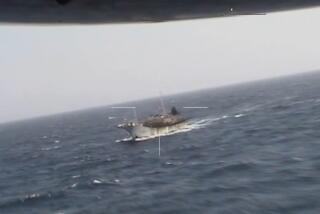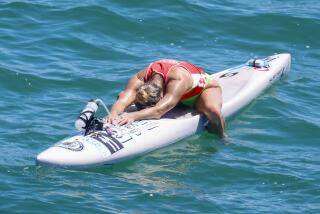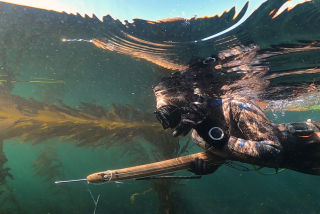In this fishing tournament, first place could mean a $1-million payday

For three days, the tournament with millions at stake becomes Las Vegas on water.
CABO SAN LUCAS, Mexico ā As the crew of the Stella June dug into plates of Asian fusion at the Chubby Noodle on sleepy Paseo de la Marina, captain Evan Salvay ran his fingers through hair shaped by a dayās worth of saltwater, wind, broiling sun and spiking anxiety.
The 27-year-old Salvay had ridden both sides of the exhilarating and sometimes cruel waves at the Bisbeeās Black and Blue marlin tournament, the richest sport-fishing chase on the planet. A year ago, a fish landed by the part-time Point Loma and Huntington Beach resident translated to just more than $3 million.
Two years ago, a potential $1-million catch was edged out by a fish 14 pounds heavier and the paycheck plummeted to $7,020.
The estimated payout for this dayās biggest catch: $1.23 million. The Stella June had caught a 466-pound black marlin that held up as the dayās best for hours on end. But 2Ā½ blocks away, a boat neared the dock with the only remaining fish left to weigh.
The glazed ribs? The salt and pepper shrimp? The thought of food nauseated Salvay. āI canāt eat, dude,ā he said.
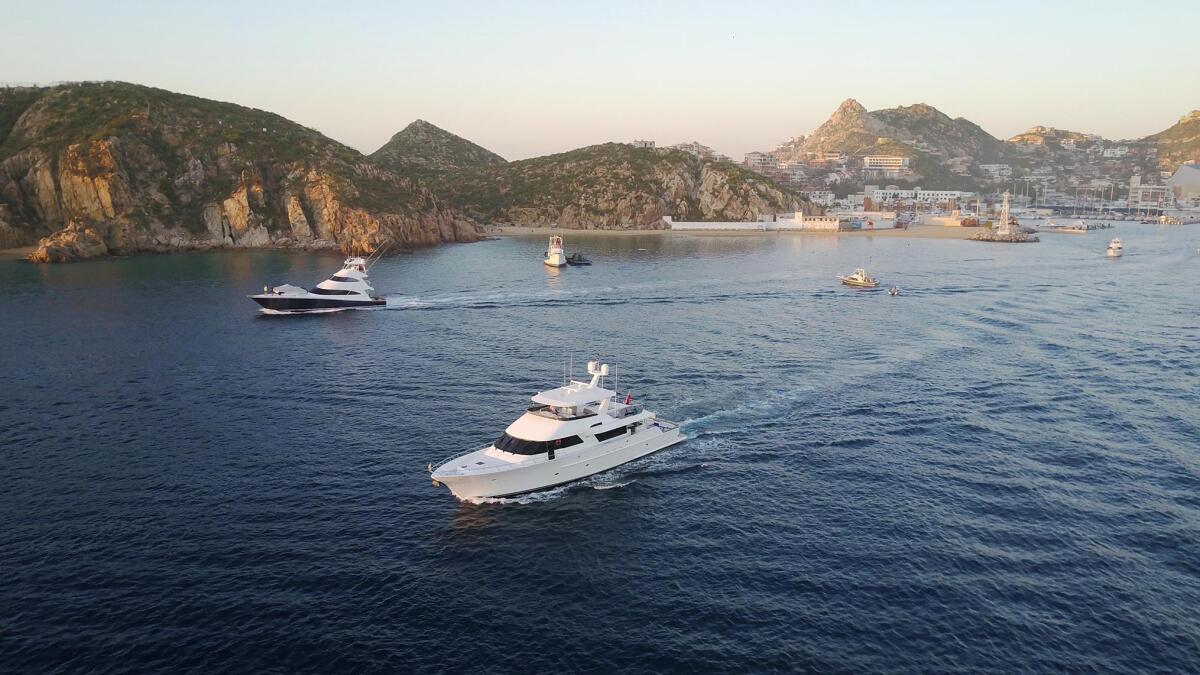
The Bisbeeās began as a marketing ploy and sun-soaked tax deduction hatched by the late Bob Bisbee, who owned a fuel dock and tackle store in Newport Beach. The tournament grew into a bait-chasing behemoth, luring anglers such as televisionās Dr. Phil, actor Jan-Michael Vincent, mixed martial artist Tito Ortiz and four-time Indianapolis 500 winner Rick Mears to join international teams sprinkled from Israel to South Africa.
For three days each October, it transforms Los Cabos into Las Vegas on water ā boasting a record $4,591,950 in prize money this year, dangled at the end of fishing lines extending from 126 boats.
The minuscule margins of error can cause tempers to rise. One year, a boat angled behind another and cut off the lures being used to coax a rare check-cashing marlin from the depths. When the teams met at the docks, the fists were about to fly.
Wayne Bisbee, Bobās son, recalled that the offending captain invited the competition onto his boat to choose lures as a peace offering. āThe next day, one of those lures won the tournament,ā he said.
Another year, participants refused to abandon the beachside awards dinner when a storm tide rushed in, continuing to drink at tables with legs submerged. There was a downtown bar crawl aboard local firetrucks as organizers flung beads Mardi Gras-style. Last year, a Louisiana captain ran up a $6,000 bar bill.
āItās controlled chaos,ā said Tricia Bisbee, Bobās daughter.
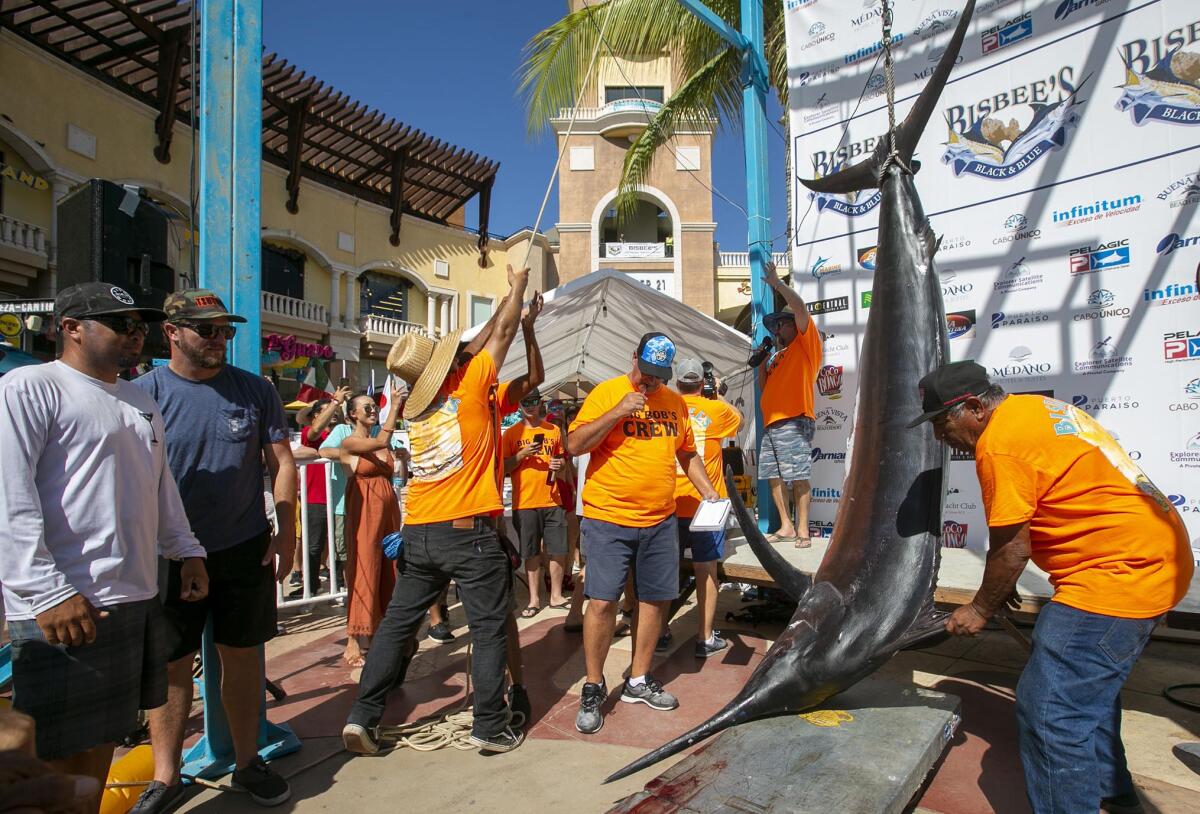
Itās also the ultimate event of sport fishing for hundreds who stalk the hulking marlin patrolling one of the richest biospheres on earth. The average release rate in the tournament ā a fish must weigh at least 300 pounds to qualify ā routinely hovers around 98%. That begins to frame the math and dizzying odds of landing a shot at millions.
Salvay and the Stella June had such a fish. What they didnāt know, as the sun darted toward the western horizon and the smell of Korean pork tacos wafted through the room, was how big, or small, their check would be. A phone buzzed as a text message rolled in. A boat named True Grit was bringing the dayās last marlin to the weigh station. The crew bounced up from the table and raced toward answers.
Salvay slipped off to his hotel room.
āIām not going to sit down there and stare at it. It is what it is,ā Salvay later explained about the tense moment on Oct. 24. āThe future has already been written.ā
The Bisbeeās Black and Blue brought together Southern California saltwater cash, Texas land barons, Chinese entrepreneurs and more to a place where the Pacific Ocean adjudicates fishing fates.
Each team paid a $5,000 base entry, but that only sniffed at the real financial investment. To win big money ā and dozens of boats glide into the marina for just that ā the gutsiest jumped at a range of jackpot buy-ins to become eligible for million-dollar paydays.
For context: The prize for the biggest fish paid nearly $108,000, while the most collective weight translated to $61,500. The money that caused 51 teams to salivate, though, was funneled into three daily jackpots costing $30,000 in total for each team.
For the first time, those daily jackpots paid out more than $1 million daily. In the previous 38 tournaments, no more than one $1 million-plus check had been earned in a single year.
Teams can contribute to various jackpots, and going āacross the boardā ā entering all the mainstream categories ā cost $71,500.
The week before in the Los Cabos Offshore, another Bisbee tournament, one boat snagged nearly $445,000 for a 328-pound blue marlin because it entered the right jackpots. The tournamentās overall winner, which brought in a 468-pound black marlin, collected much less ($89,530).
āIs there an element of gambling?ā asked veteran San Diego angler Cory Grodske, who helped La Jolla owner Bill McWethy to paydays of $685,000 and $765,000 in 2016 and 2017. āYou bet.ā
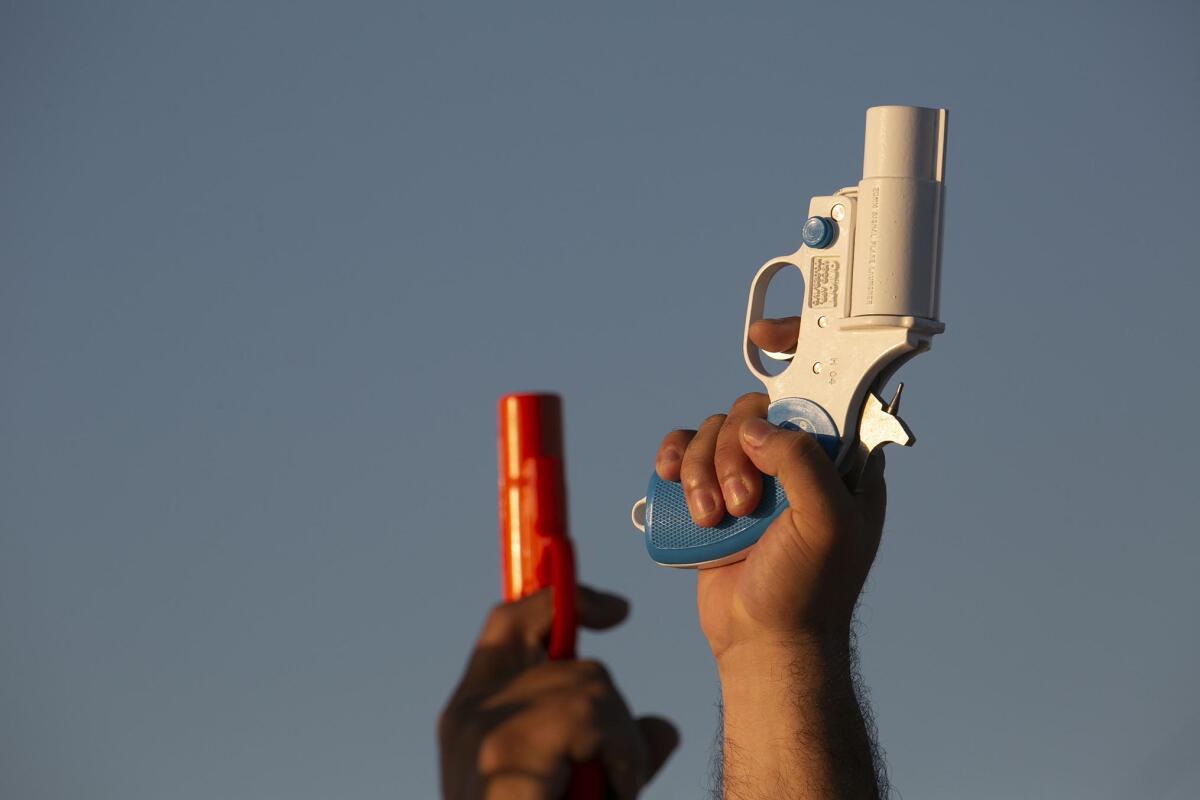
At 7:45 a.m. each day, boats huddled behind an imaginary start line that extended from Caboās endlessly photographed Arch past a double-decker start boat with flare guns. They fished anywhere within a 40-mile radius of Cabo, with options in both the Sea of Cortez and the Pacific. Lines had to be out of the water by 5 p.m., and teams had until 9 p.m. to weigh in.
Teams had to report by radio the time, species and location of the fish hooked. Since 2000, the tournament has required a member of teams that cash checks to undergo a polygraph test. Just two have failed, Wayne Bisbee said.
Anglers flood in from around the globe. Organizers estimate a combined 10% routinely compete on teams from Japan and former Soviet republics. The sportās best captains and crews rush to Cabo as well.
āIf you went down to the Great Barrier Reef to fish, donāt even bother,ā Wayne Bisbee said. āAny Australian crew worth their salt, whoāve caught anything, theyāre hired guns here. Same with Kona in Hawaii. Donāt go to Kona this week. Any captain worth a damn is here.ā
The frenzied daily competition started at 8 a.m., spiked with adrenaline before a line hit the water. Think of a Formula One race in Europe, where cars go from stationary to top speed in a blink, zigzagging for valuable position. At the Bisbeeās, the ācarsā come in different sizes with wildly varying horsepower.
Some boats eclipsed 40 knots, nearing 50 mph, as they bolted for the boundless blue. Others found themselves rocking in the overlapping wakes like a tennis shoe in a washing machine.
Earlier, anglers had shared a video from a tournament immediately before the most recent Bisbeeās that showed a boat cutting behind a competitor at high speed. The anchor-holding pulpit extending from the bow completely crossed over the neighboring stern. If anyone had been on the stern, the consequences could have been catastrophic.
Trouble has sometimes found boats and crews immediately. A decade ago, just minutes after the start, tournament officials raced to rescue the crew aboard Bottom Line as it caught fire and sank before anyone could retrieve passports, wallets or other belongings. Another time, a classic, custom-made boat lost a plank in its hull and gulped water as it sped up. It was gone in minutes.
āAnd believe it or not, it was the same captain who was on the boat that burned,ā Wayne Bisbee said.
Mike Kusler, the owner of Kusler Yachts at Kona Kai Marina in Hawaii, fished his first Bisbeeās aboard a 70-foot Hatteras named Resilient. They released a blue marlin, but Kusler was hooked by the spectacle.
āJust seeing all that fiberglass at the lineup for the shotgun, seeing all the money caught up in boats, I was awestruck,ā he said. āThereās hundreds of millions of dollars on that start line. This is the mecca of our industry.ā
Among contenders, the Stella June ā a 45-foot SeaHunter ā proved the most unusual. The open-air center console lacks the cushy, climate-controlled salons available on most top boats. The Stella June offered just a sliver of shade, so the team dipped towels in icy water to drape around necks. They converted a bucket into a makeshift bathroom.
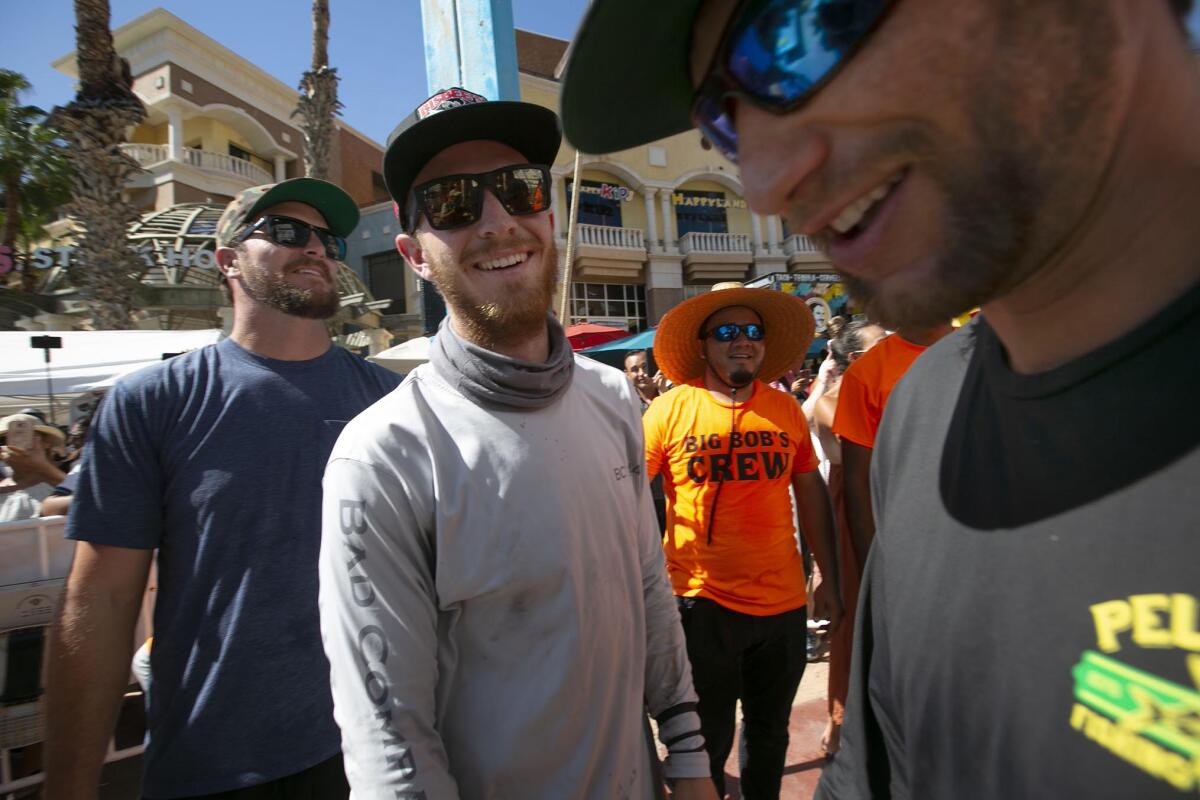
They cranked rap to buoy spirits as they fished with 5-pound skipjacks. The team competed without a fighting chair, a stern-end staple for elite participants who maximize the leverage and support the chair provides. Aboard the Stella June, the 466-pounder was fought in a stand-up harness by Jazz Moorhead of Costa Mesa and Ryan Griffin of Newport Beach.
On Day 2 of the competition, Griffin ā who routinely tracks monster marlin in Kona ā saw an owl spying on the crew as the group made the predawn walk to the marina.
āWeāre competing against 120-something boats and the best fishermen in the world, hands down,ā said Griffin, 34. āThis can be life-changing. I saw that owl majestically fly off and said, āIn Hawaii, thatās really good luck.ā ā
It was. Thatās the day they reeled in their contender.
At 1:32 p.m., they collected just one of five black marlin caught that day and one of just two potential contenders they landed in the tournament for owner and angler Ivan Vanortwick, who made his money through Jungle Boys, a cannabis collective in Los Angeles. They tugged on the giant fish for 121 minutes.
But at the Bisbeeās, failure roundly trumps triumph.
āItās emotional,ā Grodske, of the C Bandit II, said of losing a fish. āThereās an adrenaline rush, then that moment of disappointment. But that canāt cause you to make a bad pitch [like in baseball]. You canāt let it unhinge you. The fish has to win some too.ā
During Octoberās three-day tournament, 175 black and blue marlin were caught. Only nine qualified after 3,402 hours of collective fishing.
As the True Grit brought in the final fish, Stella June crew members raced down an empty alley leading to the bustling marina. Griffin, Moorhead and Seth Dubois of Orange wiggled into a weigh station mosh pit packed with fishermen, confused tourists and locals.
A day earlier, a marlin of the identical weight ā 466 pounds ā earned $1.75 million. Salvay tried to explain the head-shaking odds of two check-chasing marlins being, for tournament purposes, the same. āThe difference is ounces that are not distinguishable on the scale,ā he said.
As True Gritās fish was raised to determine its financial worth, no one among the sweaty mass realized the identities of the three men from Stella June ā or what was at stake as they jostled among them.
Wayne Bisbee grabbed a microphone to bark out their fate.
Salvay had played all the angles. Plied the right water. Enticed the right bite. Now, in his hotel room, he just had to wait.
Was his lottery ticket waiting? For an unprecedented second time? Two years in a row?
Griffin, Moorhead and Dubois craned their necks. Bisbee bellowed into the microphone. āFour-hundred ā¦ NINETY-EIGHT POUNDS!ā
Poof.
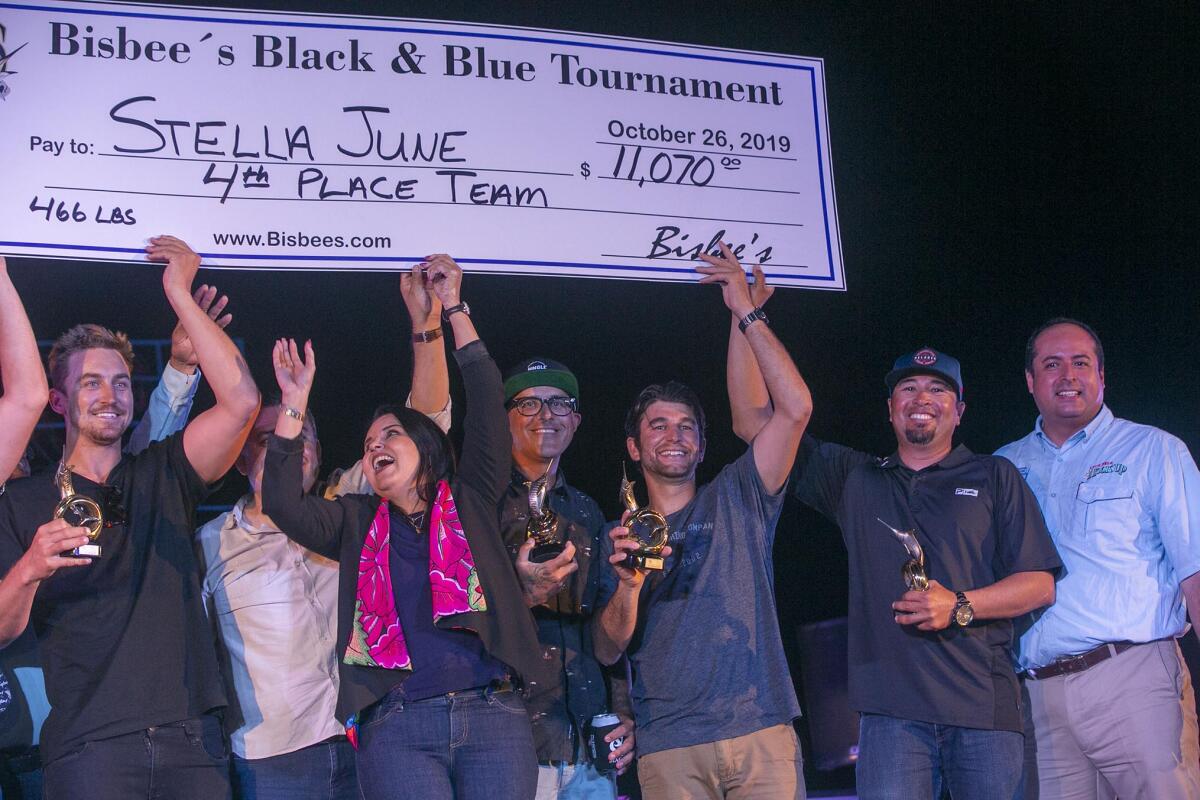
The nearly $1.3 million became $11,070 for ultimately finishing fourth in the tournament. The three teams in front of them joined the millionaire club. An additional $24,625 in tournament and captainās prizes melted away by finishing one spot too low.
āI got a text and said, āAll right, Iām going to bed,ā ā said Salvay, detailing how he processed the jarring news.
āWe won $3 million last year. Weāve been at the top and Iāve had this exact same thing happen. Iāve seen the whole spectrum. It would have been devastating a couple years ago. It was devastating a couple years ago.
āIt hurts a little bit, for sure. But you wake up the next morning, you sleep it off and you put it in perspective.ā
Some of the Stella Juneās crew had termed the potential to earn six-figure paydays ālife-changing.ā But they shed the dreaded news with grace. At the awards banquet, they smiled, back-slapped and acted as if they were about to celebrate a big payday. The salve? Another tournament was 363 days away.
āWhen you come down here to essentially the Super Bowl of fishing and weigh in a fish and get a podium finish, get a little trophy, get a little check, itās really about the experience,ā Salvay said.
An experience like no other.
Miller writes for the San Diego Union-Tribune.
More to Read
Go beyond the scoreboard
Get the latest on L.A.'s teams in the daily Sports Report newsletter.
You may occasionally receive promotional content from the Los Angeles Times.
